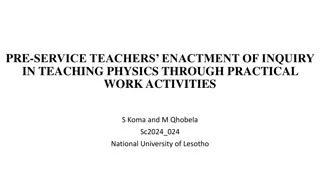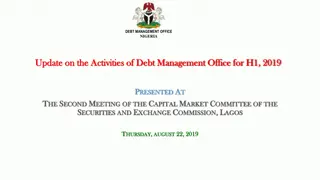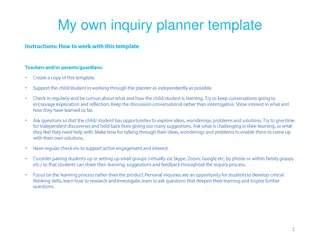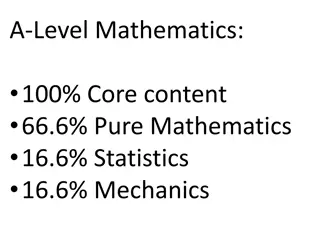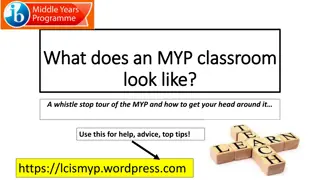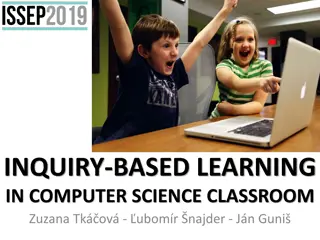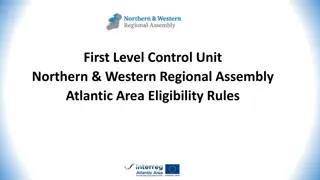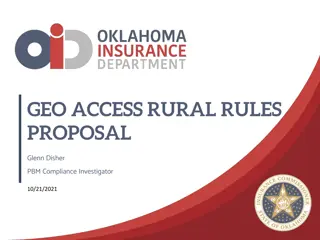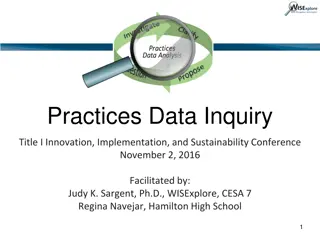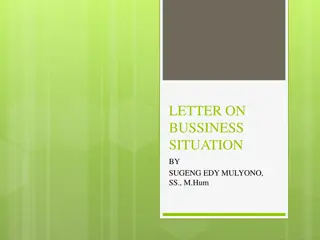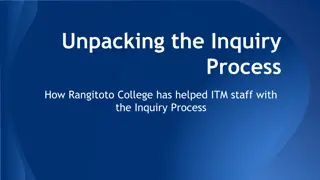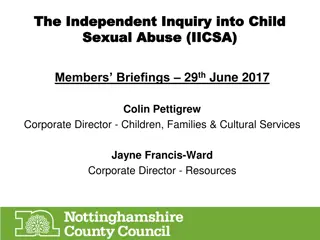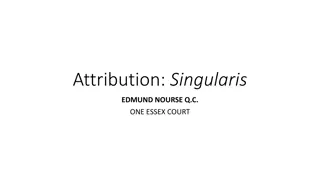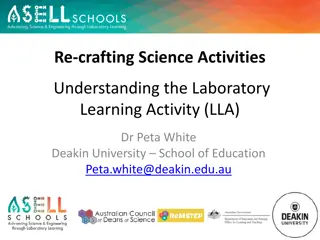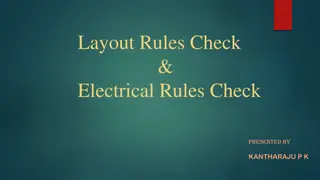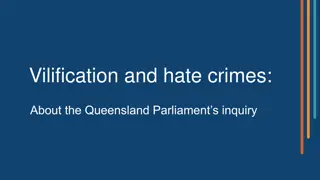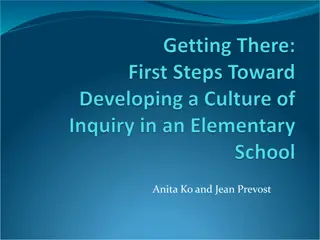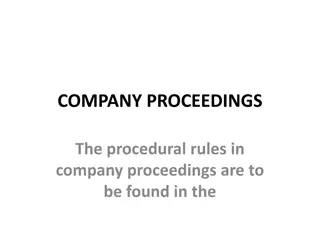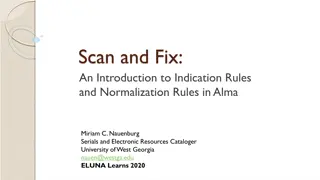
Teacher Competencies and Affective Characteristics
Explore the complex world of teachers' beliefs, attitudes, and emotions, and how they influence teaching practices and classroom interactions. Discover the development of beliefs and how they shape perception and actions in educational settings.
Download Presentation

Please find below an Image/Link to download the presentation.
The content on the website is provided AS IS for your information and personal use only. It may not be sold, licensed, or shared on other websites without obtaining consent from the author. If you encounter any issues during the download, it is possible that the publisher has removed the file from their server.
You are allowed to download the files provided on this website for personal or commercial use, subject to the condition that they are used lawfully. All files are the property of their respective owners.
The content on the website is provided AS IS for your information and personal use only. It may not be sold, licensed, or shared on other websites without obtaining consent from the author.
E N D
Presentation Transcript
IMI-BAS, Sofia, R. Bulgaria, February 14, 2015 Slagjana Jakimovik University Ss. Cyril and Methodius Skopje Faculty of Pedagogy St. Kliment Ohridski Republic of Macedonia
Teacher competencies Affective motivational characteristics: Professional beliefs, motivation and self- regulation Cognitive abilities: Professional knowledge Mathematics content knowledge (MCK) General pedagogical knowledge (GPK) Pedagogical content knowledge (PCK) Beliefs about: mathematics, teaching and learning mathematics Professional motivation and self - regulation (Shulman, 1985) (Richardson, 1996; Thompson et al., 1992) Figure 1. Conceptual framework of teacher competencies (Bl meke, S. & Delaney, S. (2012). Assessment of teacher knowledge across countries: A review of the state of research. ZDM 44 (3), 223-247.) 2
Affect (Beliefs, Attitudes, Emotions) Phillip, R. A. (2007). Mathematics teachers beliefs and affect (Ch.7 in F. K. Lester (ed.), Second Handbook of Research in Mathematics Teaching and Learning, 257-315) Affect a disposition or tendency or an emotion or feeling attached to an idea or object; comprised of Beliefs psychologically held understandings, premises, or propositions about the world that are thought to be true Attitudes manners of acting, feeling or thinking that show one s disposition or opinion Emotions feelings or states of consciousness, distinguished from cognition. Beliefs more cognitive harder to change not felt intensely Attitudes less cognitive easier to change moderate + or - feelings Emotions not cognitive change rapidly intense + or feelings 3
Beliefs lenses which filter a complexity of situation to make it comprehensible, shaping individuals interpretations of events Beliefs influence perception; predispose toward action Develop gradually; cultural factors play a key role in their development Some beliefs (primary) serve as the foundation of other beliefs (derivative) in a quasi-logical structure Central beliefs are held strongly, peripheral beliefs are more susceptible to change Beliefs are held in clusters relatively isolated from other clusters Beliefs systems may appear contradictory or inconsistent to an observer Beliefs are context specific and situated. 4
Studying Teachers Beliefs (and Knowledge) Why? Teachers beliefs and knowledge shape teachers actions Research studies demonstrate that teachers practices are consistent with teachers beliefs about mathematics to a higher degree than with teachers beliefs about teaching and learning (Phillip, 2007) Teachers practices impact students development of mathematics proficiency Mathematics proficiency comprised of five interrelated strands: Conceptual understanding Procedural fluency Strategic competence - the ability to formulate, represent, and solve mathematical problems Adaptive reasoning - the capacity to think logically and to justify one s reasoning Productive disposition perceiving mathematics as useful and worthwhile , seeing oneself as an effective learner and doer of mathematics (Adding It Up, NRC, 2001) 5
TEDS-M (Teacher Education & Development Study in Mathematics) An IEA cross-national study to provide data on the knowledge that future primary and lower-secondary school teachers acquire during their mathematics teacher education including their beliefs. Likert-type scales development informed by several studies: Teaching and Learning to Teach Study, at Michigan State University (Deng, 1995; Tatto, 1996, 1998, 2003) MT21 Report (a feasibility study for TEDS-M) (Schmidt et al., 2007) Beliefs about the nature of mathematics Beliefs about learning mathematics I. II. III. Beliefs about mathematics achievement Questions represent two views consistent with: Conceptual and cognitive-constructivist orientations Calculational and direct transmission orientations. A. B. 6
I. Beliefs About the Nature of Mathematics I-A. Mathematics as a Process of Inquiry Mathematics involves creativity and new ideas. 1. In mathematics many things can be discovered and tried out by oneself. 2. If you engage in mathematical tasks, you can discover new things (e.g., connections, rules, concepts). 3. 4. Mathematical problems can be solved correctly in many ways. Many aspects of mathematics have practical relevance. 5. 6. Mathematics helps solve everyday problems and tasks. 7
I-B. Mathematics as a Set of Rules and Procedures Mathematics is a collection of rules and procedures that prescribe how to solve a problem. 1. Mathematics involves the remembering and application of definitions, formulas, mathematical facts, and procedures. 2. When solving mathematical tasks, you need to know the correct procedure else you would be lost. 3. 4. Fundamental to mathematics is its logical rigor and precision. To do mathematics requires much practice, correct application of routines, and problem solving strategies. 5. 6. Mathematics means learning, remembering, and applying. 8
II. Beliefs About Learning Mathematics II-A. Learning mathematics through Active Involvement 1. In addition to getting a right answer in mathematics, it is important to understand why the answer is correct. 2. Teachers should allow pupils to figure out their own ways to solve mathematical problems. 3. Time used to investigate why a solution to a mathematical problem works is time well spent. 4. Pupils can figure out a way to solve mathematical problems without a teacher s help. 5. Teachers should encourage pupils to find their own solutions to mathematical problems even if they are inefficient. 6. It is helpful for pupils to discuss different ways to solve particular problems. 9
II-B. Learning Mathematics by Following Teacher Direction 1. The best way to do well in mathematics is to memorize all the formulas. 2. Pupils need to be taught exact procedures for solving mathematical problems. 3. It doesn t really matter if you understand a mathematical problem, if you can get the right answer. 4. To be good in mathematics you must be able to solve problems quickly. 5. Pupils learn mathematics best by attending to the teacher s explanations. 6. When pupils are working on mathematical problems, more emphasis should be put on getting the correct answer than on the process followed. 7. Non-standard procedures should be discouraged because they can interfere with learning the correct procedure. 8. Hands-on mathematics experiences aren t worth the time and expense. 10
III. Beliefs About Mathematics Achievement Mathematics as a Fixed Ability Since older pupils can reason abstractly, the use of hands-on models and other visual aids becomes less necessary. To be good at mathematics, you need to have a kind of mathematical mind. Mathematics is a subject in which natural ability matters a lot more than effort. Only the more able pupils can participate in multi-step problem- solving activities. In general, boys tend to be naturally better at mathematics than girls. Mathematical ability is something that remains relatively fixed throughout a person s life. Some people are good at mathematics and some aren t. Some ethnic groups are better at mathematics than others. 1. 2. 3. 4. 5. 6. 7. 8. 11
Pilot Study for a Larger National Study The beliefs of prospective primary school teachers and pre-school teachers about the nature of language and of mathematics and about teaching and learning language and mathematics national project at Ss Cyril & Methodius University Skopje respondents prospective teachers in their final semester at each teacher education department in Macedonia Pilot survey administered at the beginning of the 2nd semester (before taking the first university course in mathematics) Sample 102 first year students (87 % female) 71 primary scho0l teacher education students 31 pre-school teacher education students Sub-sample (survey & mathematics items respondents) 71 12
Disagree- Strongly disagree Slightly disagree- Slightly agree Agree - Strongly Agree Survey results in % (102 respondents) Mathematics as a Process of Inquiry / 25.8 74.2 Mathematics as Set of Rules and Procedures / 22.4 77.6 Learning Math. through Active Involvement / 24.8 75.2 Learning Math. through Teacher Direction / 78.5 21.5 Mathematics as a Fixed Ability 10.5 81.0 8.5 What is the nature of these beliefs? Which beliefs are teacher-students inclined to act upon? 13
Mathematics Survey Items: Descriptions and Results Respondents were asked to: Analyze 4 pictorial representations of multiplication of two fractions (3 were correct models, two of which very similar) and choose if only one of them (which one), more than one (which ones), or none correctly modeled the operation. 1) More than 50 % of the respondents chose only one! 2) Find the solution to a given quadratic equation using one of two methods (an example was presented using each of them): finding the roots as two whole numbers whose sum is the negative of the linear coefficient (7) and whose product is the free term (12) finding the roots using the quadratic formula More than 85 % of the respondents chose to use the formula! 14
3) Choose the method expected to be used by grade 4 pupils in finding the area of a triangle with vertices on 3 different sides of a grid composed of unit squares: Directly using the formula: length times height over two (impossible) A. Using Pythagoras's Theorem to calculate the lengths of the sides and then Heron s Formula for the area of a triangle (both given). B. Using the Distance formula to calculate the lengths of the sides and then Heron s Formula for the area of a triangle (both given). C. Finding the area of the 3 outer rectangular triangles by halving the number of unit squares in 3 rectangles and subtracting their sum from the area of the grid. D. Other _________________________________________________ E. Responses: A 34 % D or E (offering an appropriate method) only 21 % B 31 % C 9 % 15
Conclusions At the beginning of initial teacher education: 3 out 4 students endorse statements supporting a view of mathematics as a process of enquiry and of mathematics learning through active involvement (conceptual and cognitive-constructionist orientation) 3 out 4 students endorse statements supporting the view of mathematics as a set of rules and procedures 1 out 4 students supports mathematics teaching through direct transmission; 3 out 4 slightly agree/slightly disagree with it (calculational and direct transmission orientation) i. ii. Yet, when approaching mathematical problems, high percentage of prospective teachers actions are aligned with the second view. 17
Possible Explanations Teachers MCK and PCK are positively related to teachers conceptual and cognitive-constructionist orientation, negatively related to teachers calculational and direct transmission orientation (TEDS-M, 2008) The pattern of beliefs held by future teachers matches the pattern of beliefs of teacher educators (TEDS-M, 2008) Teachers beliefs (and knowledge) develop as a result of their learning experiences ( years of apprenticeship ) The process of mathematics learning (and of becoming a mathematics teacher) is a process of enculturation, of becoming a member of a community of mathematics learners. 18
Changing Beliefs If beliefs serve as lenses which filter how an individual sees the world, how can they be changed? Many researchers attempt to develop mechanisms for influencing teacher beliefs: Teachers beliefs change if teachers evidence positive changes in student learning outcomes. Providing (prospective) teachers with opportunities to learn about students mathematical thinking and reflect upon the experiences. Immersing (prospective) teachers in a community so that they become enculturated with beliefs through cultural transmissions. Changing teacher education in line with these beliefs. (For a review of research literature on teachers beliefs, see Phillip, 2007) 19
Stairs to the Castle b, bs, bl, bsl, bssl, bsssl (b-bridge, s-short, l-long) Magdalena , independent constructor (3,5 years old, August 12, 2013) 20

